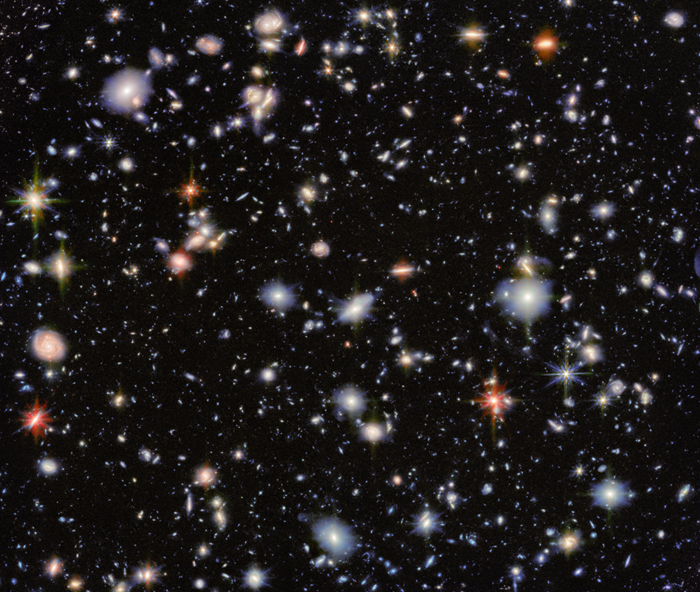The first galaxies in long-wavelength infrared light have been observed for the first time, thanks to images captured with the James Webb Space Telescope's (JWST) MIRI infrared sensor. These images offer fresh perspectives on the formation of the earliest galaxies more than 13 billion years ago, along with a new study that was published in Astronomy and Astrophysics.

This image combines data from the JWST's MIRI and NIRcam cameras to create a multicolored view of the Hubble Ultra Deep Field. The green, orange, and red hues come from MIRI and reveal the reddest galaxies and stars in the field. This image was selected as the European Space Agency's Picture of the Month for August. Image Credits: ESA/Webb, NASA & CSA, G. Östlin, P. G. Perez-Gonzalez, J. Melinder, the JADES Collaboration, the MIDIS collaboration, M. Zamani (ESA/Webb).
In the images, we can see the most distant galaxies known to us.
Göran Östlin, Professor, Department of Astronomy, Stockholm University
The study reports on the research team's observations of the Hubble Ultra Deep Field (HUDF), the region of the sky that has been most often examined by a variety of observatories, including ground-based VLT and ALMA and space-based Hubble and James Webb.
Östlin added, “What is unique about our observations is that they are made in mid-wavelength infrared light and with an extremely long exposure time, close to 100 hours. This allows us to study extremely distant galaxies. They emitted their light more than 13 billion years ago, near the beginning of the universe.”
Closer to the Big Bang
Understanding how and when the stars in the first galaxies evolved is made feasible by MIRI observations. Only the light of newborn stars in these galaxies has been recorded in previous observations.
With MIRI, we can estimate the number of stars that formed even earlier, near the Big Bang. This gives us the opportunity to study how the first galaxies evolved in the early days of the universe.
Jens Melinder, Researcher, Department of Astronomy, Stockholm University
Elements and Black Holes
The research team could also use mid-infrared light to study dusty galaxies, some of which harbor black holes. These galaxies are packed with interstellar dust that absorbs blue light from stars. As a result, the light that escapes and reaches us does so primarily in the infrared range.
“MIRI allows us to see through the veil of dust and observe what lies behind. By observing this type of galaxy, we can understand how quickly the heavier elements that the dust is made from formed in the early universe, and how supermassive black holes, surrounded by a ring of hot dust, evolved,” added Jens Melinder.
New Images and Data Available
The study makes all images and measurements available to researchers worldwide for download and usage.
“We have contributed brand new data that will be used in future by researchers studying galaxy evolution and the formation of the first galaxies. The HUDF is such an incredibly well-observed part of the night sky that there is great value in making our images available. We expect them to be used by many,” stated Jens Melinder.
Journal Reference:
Ostlin, G., et al. (2025) MIRI Deep Imaging Survey (MIDIS) of the Hubble Ultra Deep Field. Astronomy and Astrophysics. doi.org/10.1051/0004-6361/202451723